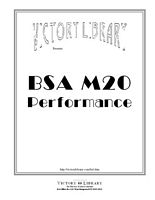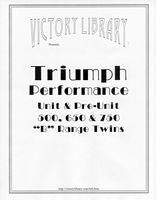
|
 |
Flywheel Weight vs. Inertia
All engines have flywheels or weighted crankshafts that balance out compression and power strokes, maintain idle, aid starting and reduce component wear. If the flywheel is too light the motorcycle requires more effort to start, idles badly, and is prone to stalling. Weight is not the important factor here, but inertia. Inertia is stored energy, and is not directly proportional to flywheel weight. It’s possible to have a light flywheel with much more inertia than a heavier flywheel.
Any power the motor develops must accelerate the flywheels before leaving the sprocket shaft, and any used in bringing the flywheel up to speed is not available at the rear wheel. This will not show up on a steady-state or rear wheel dyno or simple desk-top dyno program, but is detectable in a transient dyno that accelerates the engine at a specific rate (300 or 600 RPM per second are common).
Flywheel inertia is stored when you rev the engine slightly before letting the clutch out - this small amount of extra power helps in getting the motorcycle underway with minimal effort. By “borrowing” power for a few seconds, the engine has to develop less to move from a standing start. Once the clutch is completely engaged, inertia can no longer be borrowed - the motorcycle can only use what it produces in “real time”.
In any event, except for when the clutch is slipped all flywheel weight reduces acceleration. There is no engine speed or other condition where extra flywheel weight helps (see note:  ). ).
However, let me clarify something that is frequently mis-stated and/or mis-understood. The amount of power a motor develops is NOT RELATED to flywheel weight. Heavy flywheels do NOT “make more torque”, this is completely fictional. The power is merely stored by the flywheels, and they only have what is diverted from the primary drive.
Obviously, there’s a certain minimum amount of flywheel inertial that should be present for several reasons:
1. idle stability
2. tolerance of high compression, cam overlap, etc.
3. better clutch operation for low speed and traffic operation
4. fewer load reversals on the driveline during low speed
5. better traction
6. the carburetor’s accelerator pump and off-idle circuit settings are closer to “real world”
7. damps vibration out some
8. oil pressure is more consistant
But, other than as needed for driver preference etc. the lowest inertia you can stand the better:
When comparing two flywheels or flywheel designs for the same engine the single most important consideration is the outside diameter. If the flywheels were simple solid discs the inertia would vary in proportion to the 4th power (^4) of the diameter. Let’s examine a pair of steel discs 8.50” OD, with the left side 2.125” wide and the right side 1.625” wide (e.g., Harley-Davidson big twin), weighing about 61 lbs. (remember: no cut-outs for shafts, balance cheeks, &c.; the actual wheels are about 18 lbs. & 14 lbs.). These could be lightened in several ways.
One alternate is to reduce the width (thickness), let’s make them both 1.00” wide. This lowers the weight to 32½ lbs. and reduces both the weight and inertia by the same proportion as the width. The resultant inertia is about 53.3% of the original, a substantial loss.
However, reducing the diameter by 1.236” to 7.264” (but keeping the widths the same at 2.125” & 1.625”) reduces the inertia to the same 53.3% of the original, while the weight is only reduced to 44½ lbs. or 73% of the original. Removing only 16 ½ lbs. from the diameter has the same effect as removing 29 lbs. from the thickness. If the diameter was reduced to 6.207” (enough to make the weight match the earlier example: width reduction only to 32½ lbs.) the inertia would drop to 53.3% of that modification, and 28.4% of the original flywheels.
This is also a mod that should be approached with extreme caution. A 45 with light flywheels and tall gearing will have to be ridden like a 2-stroke.
The lighter flywheel:
1. is harder to kick through
2. requires slightly higher idle speed screw setting for stable idle
3. is more likely to stall when cold/out of tune
4. is easier to shift
5. has better braking (unless you disconnect the motor by pulling the clutch in while braking)
6. requires more delicate touch with the clutch in traffic
7. harder on the primary chain
8. less tolerant of “walking speed” in gear
1. improves acceleration
2. improves braking
3. better suspension compliance in non-IRS where flywheel gyro wraps up the springs under brakes
4. reduced overall weight
Best acceleration improvement in machines using small motor sprockets (more effect from a 20 than a 24, etc.)
Slightly harder to kick through, due to lack of inertia to “carry over” into the compression stroke
Slight increase in carb idle setting may be necessary to hold the motor at the same idle speed, due to more irregular pulses (most noticeable in motors with high compression)
Slightly higher idle speed may be necessary to prevent motor from stalling, same reason
More careful clutch operation will be required for getting away from a dead stop
In general, the motor will run slightly rougher at low speeds, and be more prone to lugging
Slightly improved braking (assuming the clutch remains engaged), as the brakes do less work slowing down the flywheels
Shifting may be improved (with practice) as the engine will conform more rapidly to the rpm required after a gear-change
Engine will appear to respond to open throttle faster in neutral; do not assume that it is safe to lean out your carb - this effect will not occur in gear, and in some cases slightly richer mixture will be required.
However: it’s worth a couple of HP in 1st gear - very noticeable. It doesn’t add any RPM (but it does RPM faster in neutral) or develop more power from the motor - it wastes less power accelerating the flywheel.
Using two right flywheels in early H-D big twins
What was commonly done is simply substituting an extra pinion (right) flywheel and re-balancing. The 2 sides are almost identical 1930-54, with the same diameter and tapers. They differ in that the rim width for is 2-1/8” left (18 lbs.) and 1-5/8” right (14 lbs.). Using 2 right flywheels takes off that extra 1/2” of rim width without lathe work. This removes 4 lbs. Engines in which a 2nd right flywheel can be used without modification (except re-balancing):
1937-39 UL/ULH 74 & 80” (8.28125” OD)
1940-48 UL/ULH 74 & 80” (8.3125” OD)
1936-40 EL 61” (8.125” OD)
1941-52 EL 61” (8.500” OD)
1941-54 FL 74” (8.500” OD)
Calculations:
A light flywheel substantially increases acceleration, but roughly proportionate to the square of the overall gear ratio. 1st gear: biggest difference, and it’s greatest with a strong (high number) 1st gear like 3.00:1 and small motor sprocket. A low number 1st gear gets much less benefit from this, not to mention the lower torque from gear multiplication.The math to predict the effect is very complex because the weight “acts” only at its mean center of mass, and it’s very tough to locate and changes when weight is removed, but I’ll bet 4 lbs. is worth at least 1-2 HP.
The effect is proportionate to the square of the overall gear ratio (gear ratio × primary × final drive). This means bikes with tall gearing or close ratios don’t get much, and no one sees any big change in high gear.
More reason for wide ratio gearing: a 4 speed with the original big twin ratios (or similar) like 1st: 3.00:1, 2nd: 1.82:1, 3rd: 1.23:1, 4th: 1.00:1 allows the bike with light flywheels to be operated in traffic easily.
How valuable is it? Inertia varies with 2 major inputs: speed and diameter (let’s leave material and density as a constant).
Inertia varies as the square of the RPM, so flywheel weight is 1.542^2 times as valuable as (for example) clutch drum weight which is slowed down by the primary chain ratio (24/37 = 1.542), or 238% as much effect for the same weight reduction. Clutch weight is the reverse: 1/(1.542^2) or only 42% as effective.
Inertia also varies as the 4th power of the radius, so weight removed from the rim (4.25” from the shaft center of a big twin flywheel) compared to weight removed from the middle (2.125” from center, like cutting out the webbing etc.) is worth the proportion^4, or 16 times as effective.
It does increase power, but the dyno programs have no way to factor this in.
The first thing a flywheel must do before accelerating the motorcycle is accelerate itself. Whatever is used to speed up the flywheel (flexplate, input shaft, etc.) is not available to accelerate the motorcycle.
The motorcycle will be faster, with the largest effect when the engine speed is highest in relation to vehicle speed: 1st gear.
Larry Widmer (who has credentials to back up his comments) states flatly that a motor with higher “transitional” power (accelerates mass X to speed Y in time interval Z) will out-perform a motor with higher steady-state dyno power.
It’s difficult to predict the results except as a comparison (as just given), but generally:
Weight removed from the flywheel OD is more important than knife-edging, hole drilling etc. because it’s farther away from the center of rotation.
Motorcycles using the highest rpm & numerical axle ratio will get most benefit.
Motorcycles with the steepest low gear (typically wide-ratio trials, military, side-car etc. gear-sets) will get more than close-ratio gear-sets.
Lighter components always develop more power. A steady-state dyno test shows similar results because the extra power was already expended speeding up the flywheel to test RPM. A steady state comparison is like testing motorcycles after the race.
Rather than attempt to settle on a test protocol (how many seconds and from what speed?), why don’t the dyno operators simply slow the flywheel down 1,000 rpm in 1 second (or × rpm in Y time - whatever produces a good span of results)? That way the inertia will “feed back” into the brake, which will show how much power was needed to stop the flywheel - should be exact proportion of power to accelerate the same mass. This should be done with spark off (duh) but WOT, to minimize any differences in vacuum, otherwise a tunnel ram motor will stop sooner than a dual-plane, etc.
Since very little power is needed (relatively speaking) to stop the flywheel, this is much safer than attempting to monitor and control the time-to-speed of a big motor at WOT.
I’ll bet there’s some money to be made by dyno operators who can offer this as a service, and money to whoever can figure out how to retro-fit the program into existing dynos...
I=1/2*M*R2
M = weight in slugs (for Earth, divide weight in pounds by 32.1; for elsewhere in the universe use the local acceleration rate of gravity; viz. the Moon is 5.3)
I = inertia
R = radius
A considerable improvement to acceleration & throttle response can be made by removing weight from the flywheels. This does not produce more power, it simply allows the engine to pick up speed more rapidly. The following effects can be expected:
better acceleration in 1st gear (less noticeable in 2nd, practically no change in 4th)
The differences in inertia, or stored energy, are much greater than the differences in weight suggest; the physics involved is complex & boring.
If not sure which weight to select (especially for a shop customer), pick the heavier of the two possible choices as the least likely to cause problems.
For your convenience, the following Table rates the flywheels, “1” = best choice, “6” = worst. |
Big Twin OHV Flywheel Comparison |
Std. 1941-* 8.50” OD |
Approximate Weight |
1st gear acceleration |
Idle quality, starting effort, smoothness |
T&O stroker, “TorqueMonster” |
34 Lbs. |
Worst |
Best |
Std. (for comparison) |
32 Lbs. |
5 |
2 |
T&O stroker, std. weight, or
2 right flywheels (1941-54) |
28 lbs. |
4 |
3 |
S&S stroker, std. weight |
25 lbs. |
3 |
4 |
S&S “A” reduced to 8-3/8” OD |
23 lbs. |
2 |
5 |
S&S “X” reduced to 8-1/4” OD |
21 lbs. |
Best |
Worst |
These factors generally suggest heavier wheels:
hot cams, especially late intake closing and/or high overlap
big carburetor without an accelerator pump (S&S Super B, etc.)
big motor and/or transmission sprockets (“highway” gearing)
high compression
foot clutch
open exhaust
heavy chassis or rider, frequent passenger, sidecar, etc.
under steady-state conditions (no speed change) more inertia is more comfortable and allows the engine to operate at a lower speed without lugging, chain snatch etc.
Raising the overall gearing (more teeth on the transmission sprocket, &c.) is one of those cases where more flywheel weight makes the bike easier to ride. The amount of throttle needed to slip the clutch (after the first blip), the RPM, and the speed at which the clutch can be fully released will all be lower without chain-snatch, bucking, etc. The power lost is also not as bad due to taller gearing, since the inertia of speeding up the crank varies as the square of the RPM, so (for example) 10% taller gearing means 21% lower loss in each gear.
There is also a problem where the engine speed is not “regular” (the speed of rotation is not constant throughout the 720° cycle). A single cylinder, or an engine with very high compression, or a light flywheel will almost stop @ TDC and BDC, be very slow after 90° ABDC on compression, and be fastest around 45°-90° ATDC on the power stroke. This is not only uncomfortable, and breaks parts in new ways (load reversals on cam gears, oil pumps, rollers), but adds new time factors to the cam lobe vs. tappet equation. This condition persists into the high RPM ranges - only recently discovered through SpinTron use.
As the number of cylinders rises the cyclic variation drops immediately, with results decaying as the number of cylinders increases with almost no detectible difference between 12 and 16 cylinders. A V12 with a heavy flywheel and 7-1 compression will have almost none of these effects.
Kevin Cameron wrote an interesting article about special circumstances where the stability of the valve gear in very high RPM racing engines was adversely affected by low flywheel inertia. The power loss through reduced valve train efficiency exceeded the advantage of low inertia. In my opinion, this observation is not relevant to any but the most serious purpose-built professional racing engines where the lowest possible inertia is already in use. Read the article here:  . .
“Lugging” refers to using hard throttle at an engine speed low enough, and load high enough, that the engine speed is not constant but almost stops at TDC & BDC.
When it happens is a function of gear ratio (almost impossible to do in 1st, except with a very small engine, easy in high gear), cam timing (especially overlap: more = worse), compression ratio (more = worse), number of cylinders (less = worse), overall sprocket ratio (lower numerically = worse), and most of all flywheel weight. With enough flywheel a 12-1 500 single can pull away from almost a walking pace. A 16 cylinder doesn’t need one.
Why is it bad?
When the engine speed almost goes to zero the oil pressure does also. All the slack, bearing clearance etc. loads reverse to the other side (CW > CCW, etc.), then back (cam gears, ignition, primary drive, gear teeth). On firing if the engine doesn’t speed up and move the “hot” piston out of the way the cylinder pressure does not decay, which causes knock which would otherwise not happen at that speed and load. |
|



















